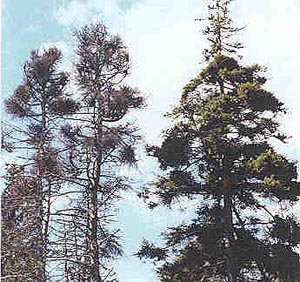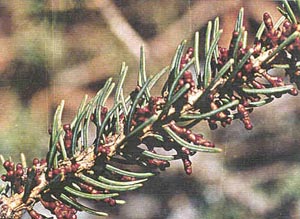DACF Home → Bureaus & Programs → Maine Forest Service →Forest Health & Monitoring → Forest Pest Index → Eastern Dwarf Mistletoe in Coastal Maine Spruce Stands
Eastern Dwarf Mistletoe in Coastal Maine Spruce Stands

Eastern Dwarf Mistletoe, a parasitic plant that stimulates the production of large twiggy growths (brooms) on native spruce, is common in some stands of white and red spruce on islands and headlands along the Maine coast. Its occurrence and impact on the host tree varies widely. In some areas, especially spruce stands adjacent to the open ocean, nearly every tree may be infected, often with multiple brooms. Heavily infected trees generally die over time, especially those with large or multiple brooms. Other stands of spruce away from the water may contain only occasional trees with small brooms. Such trees may survive for many years.
The Disease Organism
Eastern Dwarf Mistletoe (Arceuthobium pusillum) is a parasitic, seedbearing plant that attacks primarily native white, red, and black spruce in Maine. Our native eastern larch is also susceptible, although the disease is not perpetuated on larch in the absence of spruce. Occasional, rare hosts include blue spruce, Norway spruce, jack pine, red pine, and eastern white pine. Arceuthobium pusillum produces mucilaginous (gooey) seeds in October that are forcibly ejected from the tips of the aerial shoots protruding from spruce needles on three year old twigs. These sticky projectiles readily adhere to needles and twigs on the same tree, nearby trees or understory trees and subsequently germinate to cause new infections. Birds and other animals coming into contact with the sticky seeds are responsible for longer range spread.

Symptoms
Brooming of trees is the most easily recognized symptom, but brooms are not always large or conspicuous. To be sure the brushy growth observed among normal tree foliage is actually the result of mistletoe attack, not the result of compact growth due to other causes, it is necessary to carefully inspect the foliage of trees, looking among the needles for short, reddish brown aerial shoots. Aerial shoots of mistletoe are most conspicuous on the portion of branches representing three year old growth, although smaller shoot "buttons" may occur on two year old growth, and residual shoots may remain on growth older than three years.
Mistletoe and the Current Spruce Beetle Outbreak
While eastern dwarf mistletoe is common in the mature and overmature stands that are presently being lost to spruce beetle, infection apparently does not predispose trees significantly to spruce beetle attack. Mistletoe infected trees die from mistletoe attack; spruce beetle infested trees die from spruce beetle attack. While the two problems may occur in the same stands, they appear to have independent effects.
Managing Dwarf Mistletoe
Eastern dwarf mistletoe poses a management threat to regenerating spruce stands. In forested areas, it is important when harvesting to identify and remove infected overstory trees. Infected spruce should also be harvested in a 60 foot buffer strip around regenerating stands to protect the young trees. Periodic checks should follow at 10 year intervals and any infected trees removed at that time. Trees other than spruces should be favored for regeneration on infested sites. Homeowners with trees in the landscape may be able to successfully prune brooms from trees if brooms are not excessively large or extensive.
More information on the Eastern Dwarf Mistletoe![]() (699 KB, PDF)
(699 KB, PDF)
MAINE DEPARTMENT OF AGRICULTURE, CONSERVATION AND FORESTRY
Maine Forest Service - Forest Health and Monitoring Division - April 1997